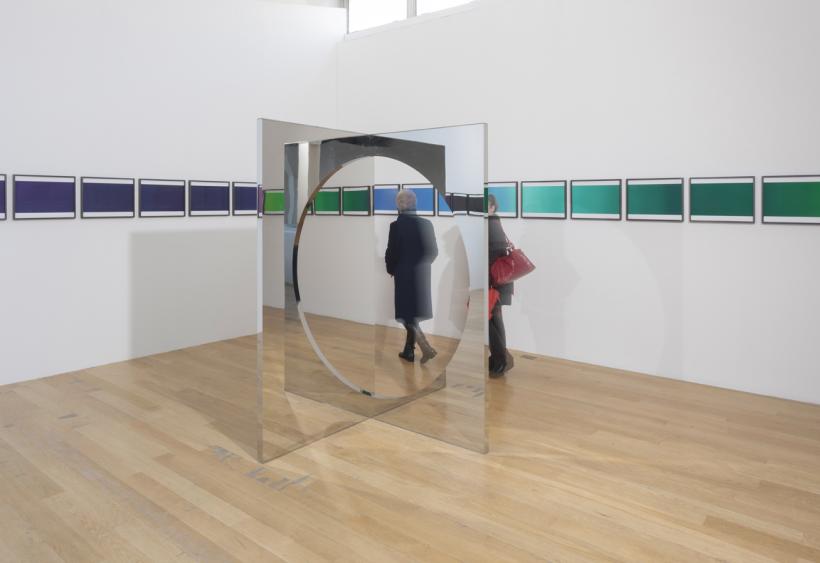As winter whittles down the daylight hours outside the Fruitmarket Gallery’s windows, inside, its spaces emit a series of elemental yet serene surges of colour and light. This is art made of nothing but the essentials of seeing, it is the legacy of the California Light and Space movement.
Growing out of East Coast Minimalism, Light and Space was tied to its West Coast roots. A loose sensibility that emerged in the late sixties, it broke with the sculptural stringencies that dominated New York, giving rise to slight and ethereal works that occupied space in increasingly expansive ways.
In this way, Light and Space offered up a distinct philosophical argument about art and its role in life. It used light to dissolve boundaries. It riffed playfully on Op Art, Minimalism, abstraction. It set out to be transcendental. It dreamed. It was not coy. It immersed the eye. It dissolved the ego. It seduced. And its philosophy, as Feldman’s show at the Fruitmarket tells us, has endured to influence artists working today.
Setting up a dialogue with the movement’s originators, Feldman has installed two vital pieces by Robert Irwin and Larry Bell. Irwin’s cast acrylic disc (1969) expands its materials into ovals of shadow and light. The whole is white, sublime, struck through by a single grey-black strip. It could be a giant motel wall light. But it’s not. It’s almost religious. Bell’s high-finish cube, too, is more than the sum of its parts. Coloured glass panes inflect light. It’s that simple. Yet the cube clears a space in your consciousness (quietly) and occupies it.
Simplicity of form and immersive transcendence in effect: this is what Irwin’s and Bell’s work is about. The artists of California Light and Space behaved almost like scientists might, each calibrating a high shine ethereal geometry that ties emotive to conceptual stimuli. To expect all the contemporary artists in Feldman’s show to do exactly this would be to ask for an extension of California Light and Space, not a dialogue with it.
Some, like Spencer Finch, whose pale and soft rainbow strip lights lean out of a darkened space, apply precision – of colour and tone – to achieve poetic ends. And only poetic terms suffice to describe the eye-lifting results. Jeppe Hein, similarly, calculates how – exactly – we can be made aware of the inherent possibilities, and vagaries, in the act of looking. His pristine leaves of intersecting mirror invite us, tongue-in-cheek, to walk through a non-existent circular portal. It’s a kind of ‘liquid architecture,’ crisp and meticulous, that intervenes, as a whimsy, in the principles of space, to rework how we occupy it. For this, Hein acknowledges a debt to Larry Bell.
In Ann Veronica Janssens’ ‘Yellow Rose’ (2007), Irwin’s influence clear. Seven yellow lights point inward into a misty haze, creating a sculpture of electrics, air and vapour, as theatrical, as visually hypnotic as an icon of faith, yet barely there. Janssens’ other piece, ‘June’, a clear bar of yellow resin placed on the floor, falls – predictably – flat in comparison. Olafur Eliason’s mesmerising ‘Ephemeral Afterimage Star’ (2008) is, unlike ‘Yellow Rose’, a dubious success. Coloured shapes are projected randomly to form a six-pointed star, which disappears briefly, leaving an imprint on the eye. The piece is big on effect, but it feels like an optical test – reminiscent of California Light and Space at its most didactic and least immersive.
Elsewhere, the artists Feldman chooses owe no direct debt to the original movement. Instead they take its tenets up via the ‘ether,’ as she puts it, of international art. Tacita Dean’s film ‘Disappearance at Sea’ (1996) follows the lighthouse at St. Abb’s Head as it strobes over sky and sea at land’s edge. Delicate and slow, with a vital soundscape, Dean’s film challenges the impoverished sensory load of everyday life, where bright light and big sound can con us into believing something significant is happening.
The most subtle of Light and Space inheritors on show here, like Dean, are concerned with the fleeting, temporal nature of the world as we observe it, and with change as a fundamental – and timeless – truth of the universe. At their most successful, each of them dreams. Each of them seduces. Each of them illuminates a personal theory of relativity that ignites our capacity for wonder.








